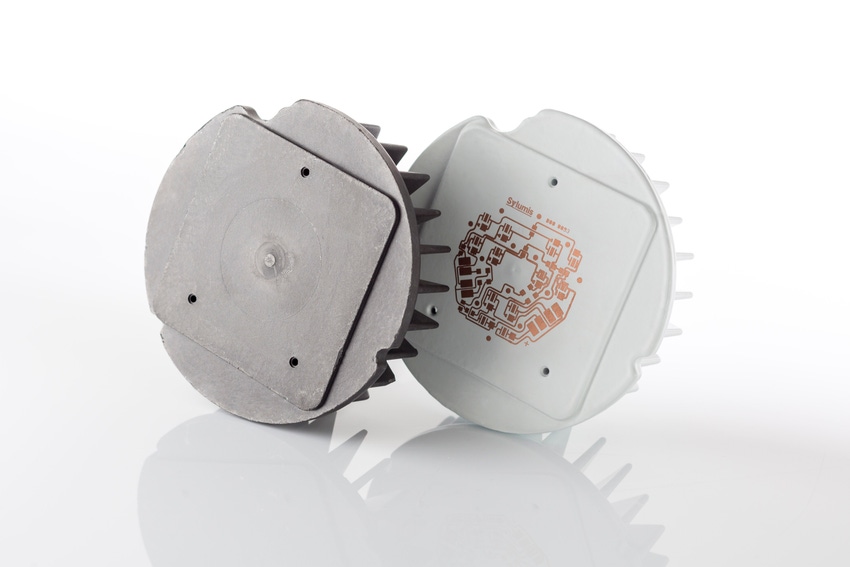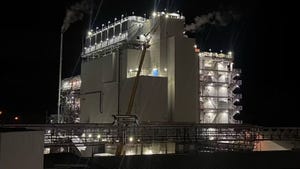PolyOne takes innovative LED assembly to next level
March 15, 2016

Since introducing the technology at the 2014 Fakuma trade show, PolyOne has worked steadily further in collaboration with a number of companies on the development of a new process for manufacturing LED functional heat sink printed circuit board assemblies. And at the VDI conference in Mannheim last week, the latest 3D MID light – “the 2.0 version”, as Jochen Kuntermann, Corporate Strategic Account Manager E&E-Automotive at PolyOne, called it – was prominently on display at the company’s booth.
 Based on 3D molded interconnect device (MID) technology, the process makes use of PolyOne’s Therma-Tech thermal management compound, from which the plastic component is molded. Using Therma-Tech thermoplastic material, which, in addition to being thermally conductive can also be formulated for electro-conductivity, has the advantage, among other things, of eliminating the need for a metal heat sink, explained Kuntermann. It also enables a considerable weight reduction to be achieved.
Based on 3D molded interconnect device (MID) technology, the process makes use of PolyOne’s Therma-Tech thermal management compound, from which the plastic component is molded. Using Therma-Tech thermoplastic material, which, in addition to being thermally conductive can also be formulated for electro-conductivity, has the advantage, among other things, of eliminating the need for a metal heat sink, explained Kuntermann. It also enables a considerable weight reduction to be achieved.
How? Replacing a metal heat sink with one molded from PolyOne’s thermally conductive material enables a manufacturer to place electronic circuits and components directly on the three-dimensional plastic components. Conventional assemblies make use of metal heat sinks to transfer heat away from LEDs, coupled with a printed circuit board for mounted LEDs. Using 3D MID technology, printed circuit boards become a thing of the past: the conductive circuit is realized directly on the 3D molded body. This cuts out a number of manufacturing steps, resulting in lower production costs, and offers a far greater degree of design freedom than hitherto possible when designing LED lamps.
The process is relatively simple: the Therma-Tech molded body is coated with a non-stick laser-activatable black lacquer, after which a laser is used to cut out the required circuit track. A plasma gun, loaded with copper metal powder, which melts into a liquid plasma stream, is used to treat the surface. The copper only adheres to the cut-out areas drawn by the laser, creating an electrical circuit, explained Kuntermann. The LEDs are then soldered on, using the lead-free reflow soldering process.
Because it’s no longer necessary for a manufacturer to purchase printed circuit boards, stock costs can be reduced, as can the assembly costs. Because the circuitry is ‘printed’ directly on the thermally conductive plastic heat sink, the contact between the electrical device and the heat sink is improved, which means that, as most failure is due to heat failure, the chance of failure goes down.
However, according to Kuntermann, the biggest difference in the transition away from metal heat sinks and PCBs is the design freedom it offers manufacturers of LED lighting. The technology allows for much greater variety in circuit designs, enabling virtually any spatial arrangement of LEDs.
Moreover, as the process is a digital one, changing the layout of the circuitry is a matter of simply reprogramming the laser. This means that medium-sized and even small series can be produced more efficiently.
According to Sylumnis, the French lighting systems manufacturer that produced the lamp exhibited at the VDI conference, a total savings of 30% were achieved on this project.
The process has also attracted significant interest in the automotive industry. Possible applications include headlamps, tail lights, dashboard lights, interior lighting, strip lights and many more.
Those interested in learning more about the process can view a 30-minute taped webinar that PolyOne conducted about the process and its potential benefits. The webinar includes a short film of the process.
About the Author(s)
You May Also Like


